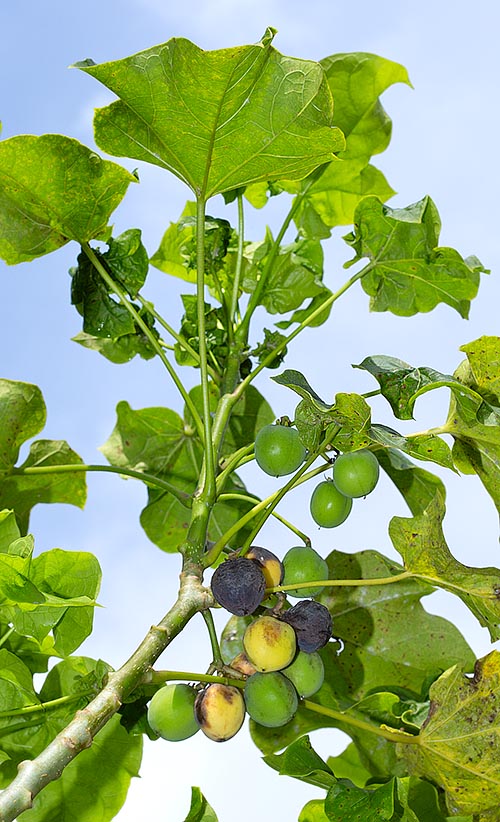Jatropha Curcas is getting value commercially as the demand of fossil fuels increases greatly and likewise Jatropha is an environment-friendly energy plantation. Plantation of this plant is thought about to be an outstanding fuel substitute and it is also really cost-effective compared to other fuels. Recently, jatropha curcas is facing some problem with insects and illness. The bugs are classified into 2 varieties: Pest that affect young plants and Pest that affect developed plants.
Young plant pests: Cutworm, Scarabeid Beetle, Army worm, Grasshopper.
Agrotis ipsilon: It is commonly understood as Cut worm. This bug impacts the seedlings and young jatropha curcas plants. If the plant is affected by the cutworm, the stem gets cut nearer to the soil surface area and this will shrunk the plant totally.
Control: This bug can be controlled by selecting the larva found around the plants or by mixing the bran, sawdust with insecticides.
Scarabaeid Beetle: This bug damages the root of the young plant. Initially, the larva takes in the raw materials present in the soil and after that concerns the root. The larva attack may eliminate the entire plant.
Control: The plant with excellent resistance power can overcome the bug. For heavy attack, insecticides with parts carbosulfan and carbofuran can be utilized to kill the bug.
Army worm: Spodoptera litura existence can be determined by biting in the leaves. The serious infection might completely eliminate the plants.
Control: Insecticides are used to manage the pests.
Grasshopper: This prevails bug found in a number of plants. Valanga nigricornis and Locusta migratoria commonly attacks the plant. The pest typically attacks the young plant.

Control: The insecticides used betacyfluthrin, cypermethrin, thiodicarb, MIPC, and fipronil.
Pest observed in mature plants:
Pest of Stem: Ostrinia furnacalis, Xyleborus spp.
Ostrinia furnacalis and Xyleborus: This insect harms the jatropha curcas stem and it is widely seen in Indonesia. The stem attacked by this pest usually drop. The presence can be recognized by the larva penetration hole at the stem.
Control: The Insecticide generally utilized to manage this bug is carbofuran.

Pest of leaf: The typical pests observed are leaf caterpillar, Neetle caterpillar, Leaf hopper, Mite, Ear corn caterpillar.

Leaf Caterpillar: This insect can eat all the leaves of the plant in other words duration. The quality and yield of the seeds get decreased due to the heavy attack.
Control: This can be managed by selecting the old larvae around the surface area and discarding the assaulted leaves.
Needle Caterpillar: This caterpillar is covered with spinal columns and produces a burning experience when allowed to contact with skin as it produces certain chemical compound. Initially the pest crowded in the leaf and then spread out all over the plant when it grows older.
Control: Manually, the bug can be eliminated only by soaking it in water or kerosene. The heavy attack can be controlled by spraying organophosphate insecticides.
Leaf Hopper: This insect is discovered mainly in tropical and subtropical regions. The bug targets the leaf and sucks all the nutrients of the leaf and gets curls at the suggestion. Later, the entire leaf dry and die.
Control: The heavy attack can be managed by utilizing insecticides like imidachloprid, beta cyfluthrin or carbosulfan.
Mite: Mite also assaults the leaf and makes the entire plant weak. The insect existence can be identified when the leaf become yellow-colored, shrinks, turns red and fall down. The bug can also be spread through fallen leaves.
Control: Some preventive procedures can be simulated correct sanitation and burning the fallen leaves. Heavy attack can be treated by spraying insecticides.
Some dreadful bug which attacks flower and fruit are, Stink bug (Nezara viridula)
Chrysocoris javanus, Tip borer caterpillar.
Stink Bug: Sting bug is a major pest which assaults the plant during bloom duration so the crop yield entirely falls down. This insect is seen around the tropical area.
The hazardous enzyme in the plant shrinks the whole plant.
Control: Insecticides advised for this bug is chlorfluazuron, diflubenzuron, alfamethrin, and lamda cyhalothrin.
Tip borer caterpillar: The bugs frequently takes place attacks the plant in flowering season and this bug is seen widely in tropical regions. The female insect laid the eggs on the tender part of the plant and the young larvae feed the young fruits and plant suggestions.
Control: Manually, the assaulted seeds are recommended to burn. The insecticides like monocrotophos and bensultap are sprayed at the blooming season.








